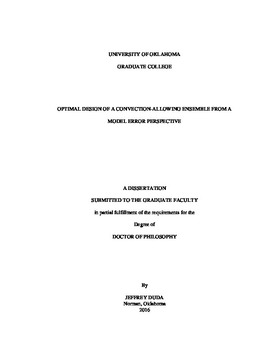| dc.contributor.advisor | Wang, Xuguang | |
| dc.contributor.advisor | Xue, Ming | |
| dc.contributor.author | Duda, Jeffrey | |
| dc.date.accessioned | 2016-06-01T14:21:50Z | |
| dc.date.available | 2016-06-01T14:21:50Z | |
| dc.date.issued | 2016-05-13 | |
| dc.identifier.uri | https://hdl.handle.net/11244/34801 | |
| dc.description.abstract | As computer technology continues to improve, resources are becoming increasingly available for running an ensemble of NWP simulations with sufficient resolution that convection parameterization is no longer needed and individual storms can be captured on the grid scale. Due to past limitations on technology, research into the optimal design of convection-allowing ensembles has remained limited.
The purpose of ensembles is to account for forecast uncertainty that arises due to errors in the forecast process. There are errors in the initial conditions resulting from incomplete spatiotemporal sampling of the atmosphere and measurement error. There are errors in the lateral boundary conditions that drive limited-area models (as is the case for current experimental convection-allowing ensembles). There are also errors associated with the model formulation caused by numerical error from discretization of the model grid, truncation of numerical schemes, and inadequate subgrid-scale physics parameterizations that provide source and sink terms for the resolved-scale variables. This dissertation focuses on methods of accounting for uncertainty in assorted model physics components.
Three research projects were performed using the WRF model with 4 km grid spacing. One investigated methods of accounting for microphysics uncertainty. Another investigated the impact of adding a stochastic model error representation scheme. The third project investigated methods of accounting for uncertainty in the land-surface model component.
Two methods of perturbing the microphysics were compared: perturbing fixed parameters within a single scheme and using multiple schemes. The latter, termed mixed microphysics, was found to generate somewhat more skillful and more reliable probabilistic forecasts of precipitation, although the former, termed perturbed parameter microphysics, also performed well.
A stochastic model error scheme that was originally created to improve large-scale forecasts in the ECMWF model was converted for use in the WRF model. The stochastic kinetic energy backscatter, or SKEB, scheme injects kinetic energy at all scales using a forced power spectrum. Its utility in a convection-allowing ensemble was analyzed and found to add significant ensemble spread while also reducing ensemble mean error. The SKEB scheme does not perturb any moisture variables, but was successful in causing slight improvements to precipitation forecasts.
The final portion of this dissertation features an exploratory study to determine a perturbation strategy for the land-surface model component. Literature review revealed many uncertainties in current land-surface models that have not been accounted for in prior experimental convection-allowing ensembles. A set of perturbations that reflect uncertainty in the calculation of sensible and latent heat flux was determined and applied to a small set of cases. The sensitivity of convection forecasts to these perturbations was assessed and compared to that from other physics perturbations (microphysics and PBL physics). It was also determined that adding land-surface model perturbations to other existing physics perturbations further increases ensemble diversity and improves probabilistic forecasts of precipitation.
Overall, it is encouraging that the WRF provides a wealth of resources for accounting for model physics uncertainty in convection-allowing NWP forecasts. | en_US |
| dc.language | en_US | en_US |
| dc.subject | Meteorology, Numerical Weather Prediction, ensemble forecasting, deep moist convection | en_US |
| dc.title | OPTIMAL DESIGN OF A CONVECTION-ALLOWING ENSEMBLE FROM A MODEL ERROR PERSPECTIVE | en_US |
| dc.contributor.committeeMember | Stensrud, David | |
| dc.contributor.committeeMember | Shapiro, Alan | |
| dc.contributor.committeeMember | Hong, Yang | |
| dc.contributor.committeeMember | Luo, Yiqi | |
| dc.contributor.committeeMember | Wang, Xuguang | |
| dc.contributor.committeeMember | Xue, Ming | |
| dc.date.manuscript | 2016-05-10 | |
| dc.thesis.degree | Ph.D. | en_US |
| ou.group | College of Atmospheric & Geographic Sciences::School of Meteorology | en_US |
| shareok.orcid | 0000-0001-9159-4681 | en_US |
| shareok.nativefileaccess | restricted | en_US |
